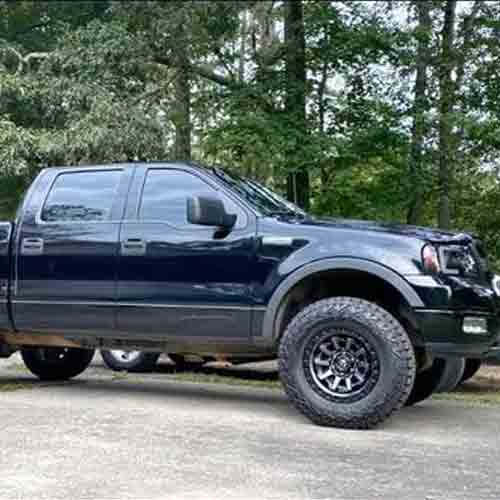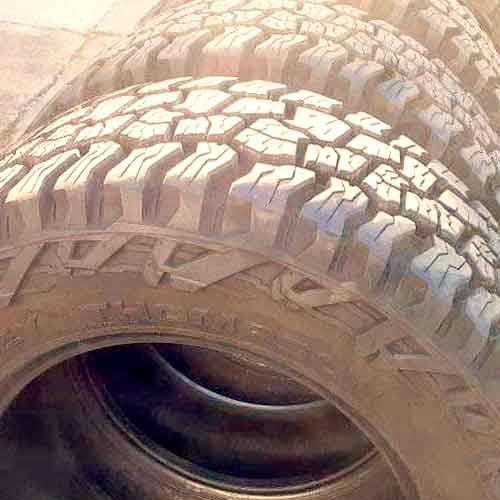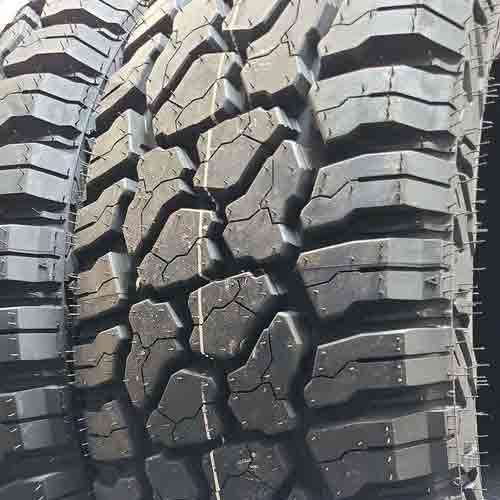Both the Mickey Thompson Baja Boss AT and the Falken Wildpeak RT are rugged-terrain tires, combining features of mud and all-terrain tires. But let’s see which tire is a better fit for your needs.

As a tire engineer, my testing shows that the Mickey Thompson Baja Boss A/T shines in winter, wet, and dry conditions, while the Falken Wildpeak RT stands out in rock climbing and sandy terrains. Though both tires demonstrate similar overall durability.
Sizes Available
The Mickey Baja Boss A/T provides 59 sizes (15″ to 24″) with following specs.
- Speed ratings: Q and T.
- Load ratings: SL, XL, D, E and F (no C).
- Weight range of 36 lbs to 90 lbs.
- Tread Depth: Either 16/32″ or 18.5/32″.
- 60k miles warranty for non LT sizes, while 50k miles for LT sizes.
On the other hand, the Falken Wildpeak RT comes in 16 to 22 inches rims, with following specs.
- Speed rating: Only R is available.
- Load rating: C, D, E and F.
- Weight range: 50 to 94 lbs.
- Tread depth range: 16 to 20/32″.
- Treadwear warranty: 50k miles on all sizes.
Design Features
Let’s start with the Mickey Thompson Baja A/T.

So this tire features an asymmetrical tread pattern, where a total of 4 ribs are seen.
The shoulders carry very biting off-set edges, with a combination of zigzag siping and A LOT of stone ejectors.
And from the central area, although both ribs are similar to each other, one of them has lugs with lateral and longitudinal slits…
While other only carries other common features among them, like sharp chamfered edges, off-set edges, triangular shaped ejectors in their grooves, and of course, siping.
And yes, worth reminding, the shoulder lugs are although not properly staggered, each shoulder block is staggered on itself, if that makes sense.
But one thing is for sure, it features much more aggressive biters on its sidewalls.
On the other side, the Falken Wildpeak RT offers an symmetrical pattern.

And since here, the middle lugs are more you can say, inter-mingled, there are no proper rib formations.
This although doesn’t allow for as much streamlined tire rolling, it does add to the tire’s overall mud and dirt evacuation capabilities, as well as hydroplaning.
These central lugs are characterized by their interlocking siping, off-set sides, and yes, stepped edges.
The shoulder lugs are less aggressive in comparison, where a combination of thick and narrow siping slits are seen.
And although the tire doesn’t give out as many stone ejectors, relatively, there are traditional ones seen between each of the shoulder blocks.
And yes, its lugs unlike the Baja AT are also properly staggered.
Winter Capability
Off-road tires have been improving in terms of winter performance, borrowing key design features from traditional winter tires.
They are now constructed with softer materials to withstand the freezing temperatures and have specially designed notches and sipes that grab onto snow particles, promoting better snow-on-snow contact.
Now, here overall the Baja Boss A/T is doing better. Let me break down both tires’ points one by one.
So in case of Mickey Thompson:
- Its rubber is more thermally adaptive (so tread remains soft even with harsh temperatures).
- It features an overall narrower section width on average (this enables biters to exert more pressure on the snow, thereby enhancing traction, by achieving better snow to snow contact (which is better as snow sticks better on snow instead of rubber).
- And yes, speaking of which, it also has more biters.
For Your Info: This aspect of tread width is crucial, which is why Baja Boss models with widths exceeding 12.5 inches do not have the 3PMSF (3 Peak Mountain Snowflake) rating).
Falken Wildpeak RT on the other hand:
- Does not possess the 3PMSF rating.
- It shines when dealing with snow that’s over 2 feet deep. Its grooves are capable of capturing and meshing snow particles, offering stability. Moreover, excessive snow is also channeled away efficiently.
- Its rubber tends to become stiffer in cold conditions, which restrict its traction, especially on snowy roads.
- Lacks a lot when it comes to ice.
For context: The 3PMSF rating measures a tire’s acceleration capabilities on snowy roads. So tires stamped with this rating offer approximately 10% better acceleration performance than the typical all-season tire.
Dry Performance
Dry performance has a lot of variables, where dry grip measures how fast a tire can stop with full braking, and lateral grip determines the overall sideways traction.
And these combined with tire’s steering give you most of the overall performance picture. Let’s discuss all one by one.
Directional Grip
As this grip is directional, it makes sense why its judged by looking at the central area of the tread (besides other variables).
And the Mickey Thompson Baja Boss A/T excels here, as it checks all boxes.
The tire of course has more tightly packed central lugs, forming greater rubber to road contact. But it also feature more biters, (both aligned longitudinally and laterally, see the tread design section).
Moreover, its overall design is although asymmetrical, its predominance of longitudinally aligned lugs, where you see two circumferential ribs clearly, allow for faster directional rolling and braking, contributing to its greater overall directional grip, comparatively.
On the other side, the Falken Wildpeak RT faces some limitations in this category.
The tire is more voided up in the middle, and does not features as many biters, where its lugs are also not as streamlined as well.
So it stops almost a foot greater, on average, compared to Baja Boss AT.
Handling
Handling is a combination of steering response and lateral traction.
That’s why in terms of lateral traction although both tires come out with similar lateral g forces, the overall handling times is seen slightly better with the Wildpeak RT.
The tire although has slightly greater tread depth (on average), its harder rubber composition, and lighter (again averaged) weight among its sizes, puts less pressure on the lugs. And with that, less overall lug bending occurs.
But why that’s significant here?
Well, you see lug flexing wastes time in to reshaping the tread back, and that causes lacking over/understeering balance.
That’s why Mickey Thompson Baja Boss A/T with its relatively heavier weight and softer compound, tends to under-steer. This characteristic, in turn, increases the tire’s response times, making its overall handling slightly less efficient on dry surfaces.
Wet Performance
Wet grip and hydroplaning are the two main things to consider here.
Let me start off with hydroplaning
Hydroplaning Resistance
The ability of a tire to resist hydroplaning is determined by how effectively it can disperse water from its tread to prevent floating.
So, its true that the balder the tire, the less it would hydroplane (or float).
That’s why both tires do great here.
In case of Mickey Baja Boss AT, the tire is designed with three straightforward longitudinal channels, which are also prominently connected laterally, so water is evacuated in all directions.
And as for the Wildpeak RT, the tire also throws water out in all directions, with its, you can say, poorly drawn X-shaped grooves.
Though if you still have to pick one, the Falken RT has a (negligible) advantage of 2/32″ greater tread depth, which takes out more volume of water. Again it doesn’t cause any notable difference when it comes to float speeds.
Wet Traction
To achieve proper grip on wet surfaces, siping is essential. Sipes are although mere slits on tread, they contract/expand, creating suction, and efficiently absorb water.
So one can imagine why these sipes (and overall tread) has to be flexible enough.
Now, the Mickey Thompson Baja Boss A/T is superb in this regard.
Besides already having a more flexible tread in comparison, the tire also features better siping design.
I mean its interlocking siping requires minimal energy to contract and expand, and grips in all directions, adding to overall directional and lateral traction.
Whereas in case of the Falken Wildpeak RT, you not only get limited siping but a harder rubber composition.
So it makes sense why it lacks by over 3 seconds, compared to Baja Boss A/T, when it comes to average handling times (on laps).
Fuel Consumption
3 things are directly proportional to overall rolling resistance of a tire.
- It’s overall weight (on average).
- It’s stickiness of its tread.
- And the speed rating it gives out.
A tire’s fuel efficiency is highly linked to its weight and the stickiness of its tread.
That’s why it makes sense why the Baja Boss A/T’s lacks here slightly with its sizes having greater speed ratings.
Moreover the tire also weighs more on average, and its relatively softer compound has a more adhesive nature, relatively, thereby demanding more energy.
On the other hand, the Falken Wildpeak RT detaches from surfaces with more ease, comparatively, leading to lower fuel consumption.
Basically, if you want to go deeper, this has to do with lug flexing, which wastes energy. (Refer to the dry handling section for further details).
Ride Quality
Overall ride quality comprises two aspects: how well the tire absorbs bumps and its ability to handle road irregularities.
Let me discuss them both.
Tread Noise
When it comes to noise, its crucial to understand the following.
- Noise originates from air.
- A tire’s tread, inclusive of its grooves and sipes, is constantly filled with air. As the tire moves, this air is pumped in and out, producing noise.
- That air also comes in directly through the shoulder voids, hitting the tread walls. And the impact of striking adds to overall noise.
That’s why it makes sense why the Mickey Thompson Baja Boss A/T is a louder tire here.
The tire has more biters, which basically create a kind of a two tone cavity sounds, whereas its numerous siping also produce a lot of growling noises.
On the other side, the Falken Wildpeak RT not only employs a “better” varied pitch pattern. Meaning, air particles colliding different parts of the lugs create varying tones, which try to cancel out each other.
And although its shoulder voids are equally spacious, in comparison, the unique shapes of its lugs and their stepped edges facilitate better air dispersion, minimizing collision frequency.
And yes, its harder rubber is also helping, which basically limits the reverberation of sound waves, slightly enhancing the tire’s noise reduction capability.
Vibrations Dampening
When it comes to a smooth and comfortable ride, the thickness of a tire’s tread plays a role. Imagine the tread as a cushion, I mean the thicker it is, the better it can absorb road bumps and irregularities.
That’s why the Falken Wildpeak RT with a thicker tread, offers a more room for bumps to settle down.
Then why it still can’t outperform its competitor here?
Well, that’s because simply put, the Mickey Thompson Baja Boss A/T comes with a softer rubber compound, which basically allows it to mold more easily over bumps, making the ride feel smoother, in comparison.
Durability
Off-road tires face numerous challenges, especially when it comes to sidewalls puncturing. Though these tires have a pretty great armor on, so that’s not an issue.
I mean, the Mickey Thompson A/T comes with a 3-ply polyester casing beneath its robust sidewall lugs, and incorporates a standard 2-ply polyester and 2 nylon cap plies at the top.
Now, the tire employ what they call, the XD ply technology, with its third layer of polyester casing being denser, and its sidewalls has thicker biters too, you can’t really put it as a more durable tire here.
This is because the Falken Wildpeak RT has a similar 3 ply polyester construction, where although its third layer isn’t thicker, it still gives extra polyamide layer around its bead area, protecting sidewalls. And that coupled with its deeper tread, the tire provides more rubber protection in its central area too.
So at best, in the durability contest, both tires are getting equal scores in my book.
Off Road Traction
Off road include a lot of terrain types, though the 3 main ones below cover most of the “off-road variables”, one is looking for.
Mud Traction
Navigating mud is arguably the most challenging terrain for tires. And here you need a lot of cleaning grooves, as without them, tires quickly become clogged (and start spinning at the same place).
Now the great thing is, both tires have remarkable mud traction capabilities.
For the Mickey Thompson Baja Boss A/T, the tire besides providing grooves in all directions, also features multiple stone ejectors, which help in breaking down mud particles, so they can leave out more easily.
While the Wildpeak RT comes with a unique wavelike groove structure on both its longitudinal and lateral channels. These grooves interconnect, facilitating the just as effective expulsion of mud in all directions, comparatively.
I mean although the tire doesn’t have stone ejectors like its counterpart, its deeper tread depth still keeps its performance up to the mark.
Gravel and Rocks
Navigating rocky terrains presents a diverse set of challenges, ranging from small rocks and gravelly roads to larger boulders that demand enhanced climbing capabilities.
Now in case of gravel, the Mickey Thompson Baja Boss A/T is exceptional, all thanks to its numerous stone ejectors. I mean if you look at the shoulder lugs alone, each block carries like 6 stone ejectors.
But in terms of bigger rocks, where climbing efficacy is judged, the tire is slightly lacking. I mean don’t get me wrong, it sill offers remarkable traction with its numerous biters, and more aggressive sidewalls.
But its overall traction is still slightly lower compared to its counterpart.
Basically Falken Wildpeak RT offers superior lug interconnectivity provides biting edges in every direction, along with a bigger groove mouth (if that makes sense).
And sure its stiffer rubber is a hurdle here, its easily fixed by lowering the air pressure.
So in summary, for gravelly roads, the Baja Boss reigns supreme, but for rock climbing, the Wildpeak RT edges out with marginally better scores.
Sand Performance
Sand is a tough terrain, where you need to make sure, your tires don’t “ever” dig in.
That’s why you need tires here with lighter construction, and having paddling like lugs, which could offer a good enough forward momentum.
Now here the Mickey Thompson Baja Boss A/T features good rim locks and strong sidewall lugs. But its heavier build and sharper edges bring it to a disadvantage, hurting its overall sand traction scores more in comparison.
On the other hand, the Wildpeak RT with its smoother edges, reduces digging. And here its lighter structure also gives it an advantage, especially when it comes to slopes.
So, What’s The Verdict?
So overall both tires are doing great in a lot of different performance sections.
The Baja Boss A/T excels in winter conditions due to its thermally adaptive rubber and narrow section width, along with superior wet and dry grip.
In contrast, the Wildpeak RT showcases strength in rock climbing and sand terrains, attributed to its superior lug interconnectivity and lightweight build.
And yes, durability-wise, both tires stand on equal footing, showcasing robust protection against sidewall punctures.